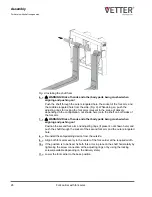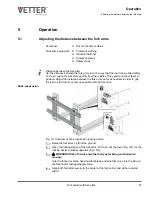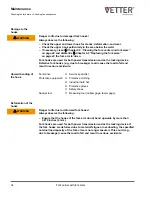
Danger to life due to deformed fork arms!
– Check the fork arms for deformation on a regular basis.
– Never use fork arms that exceed the maximum permissible height difference.
A difference in height between the fork tips of the mounted fork arms indicates
deformation of the fork blade or that a fork arm has bent upwards. If the height
difference of the fork arms exceeds a certain value
Δ
hmax (1.5% of the blade
length), the specified nominal load capacity of the fork arms is not longer
ensured. This could (e.g., due to breakage) cause the load to fall and result in
serious accidents.
Fig. 16: Height difference, fork tip
1.
Calculate the maximum permissible height difference hmax:
Δ
hmax = (blade length [inches] / 100) x 1.5
2.
Mount the fork arms on the fork carrier and move them to a comfortable working
height.
3.
Place a level (or ruler) above both fork tips and, in doing so, put it flush against
the higher fork arm.
4.
Measure the difference h between the level and the lower fork blade at the fork
5.
If the measured height difference h exceeds the calculated value for hmax,
immediately ban any further use of the fork arm. Commissioning must only be
carried out after a successful repair or replacement.
Personnel:
n
Service specialist
Protective equipment:
n
Protective clothing
n
Industrial hard hat
n
Protective gloves
n
Safety shoes
Deformed fork arms
L
WARNING
Wear/damage to the
fork tip
Maintenance
Checking the fork arms > Deformation of the fork arms
Fork carrier with fork arms
40
Summary of Contents for ManuTel
Page 2: ...Fork carrier with fork arms 2 ...
Page 52: ......



































